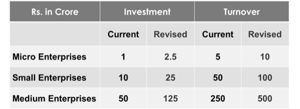Udyamee, Ahmedabad:
In a game-changing move to strengthen India’s micro, small, and medium enterprises (MSMEs), Finance Minister Nirmala Sitharaman, in her Union Budget 2025-26 speech, announced a significant revision in the classification criteria for MSMEs. The investment and turnover thresholds have been increased to 2.5 times and 2 times, respectively, allowing businesses to scale operations, upgrade technology, and access higher capital.
This reform is expected to benefit over one crore registered MSMEs, which currently employ 7.5 crore people and contribute 36% to India’s manufacturing sector. Recognizing their role in exports—where MSMEs account for 45% of India’s outbound trade—the government is also enhancing credit access, raising the credit guarantee cover for micro and small enterprises from ₹5 crore to ₹10 crore, and introducing customized Credit Cards with a ₹5 lakh limit for micro enterprises.
Additionally, a Fund of Funds with ₹10,000 crore is being set up to support startups, along with a new scheme tailored for women, Scheduled Caste (SC), and Scheduled Tribe (ST) entrepreneurs. With India eyeing global leadership in manufacturing and innovation, these measures aim to make the MSME sector more competitive, resilient, and employment-generating in the coming years.

What Do These Changes Mean?
The revised MSME classification under Budget 2025-26 significantly expands the investment and turnover limits, offering enterprises greater flexibility to grow without the fear of losing MSME benefits. Here’s how each category is affected:
- Micro Enterprises: Previously, micro units were restricted to an investment of ₹1 crore. Under the new classification, they can now invest up to ₹2.5 crore and generate an annual turnover of up to ₹10 crore. This revision provides small-scale entrepreneurs the breathing room to expand operations without the risk of being prematurely reclassified, allowing for smoother scalability.
- Small Enterprises: The investment ceiling has been raised from ₹10 crore to ₹25 crore, and the turnover limit has doubled from ₹50 crore to ₹100 crore. This change facilitates a more seamless transition for growing micro-enterprises, enabling them to move up the ladder without facing abrupt regulatory shifts. The increased threshold also makes small enterprises more attractive for funding and partnerships.
- Medium Enterprises: The most significant expansion is seen in this category, where investment limits have surged to ₹125 crore, while turnover thresholds have jumped to ₹500 crore. This change empowers medium-sized firms to scale operations, compete in international markets, and attract higher foreign and domestic investments. With larger capital backing, these enterprises can now expand into new industries, improve production capabilities, and enhance competitiveness on a global scale.
Key Benefits
The revised classification doesn’t just redefine size thresholds—it brings substantial financial, operational, and competitive advantages to India’s MSME sector.
- Access to Collateral-Free Loans: With the new MSME definition, businesses can leverage government-backed credit guarantees and specialised loan schemes from banks and NBFCs. Many financial institutions offer lower interest rates for MSMEs, reducing capital constraints and making expansion more feasible.
- Participation in Government Tenders: A significant portion of public sector contracts is reserved for MSMEs. With larger enterprises now qualifying under the MSME umbrella, more businesses can participate in high-value government projects, ensuring fair competition and increased revenue opportunities.
- Tax and Duty Exemptions: MSMEs enjoy various tax incentives, including lower GST rates, customs duty exemptions, and direct tax rebates, depending on their industry. The expanded limits allow businesses to retain these benefits longer, improving their profitability and sustainability.
- R&D and Technology Adoption: The government actively supports MSMEs in modernising operations, investing in research & development (R&D), and adopting new technologies. Revised classification allows more firms to qualify for innovation grants, skill development subsidies, and technology-upgradation schemes, helping them remain competitive in a fast-evolving market.
The revised MSME classification marks a transformative shift for India’s business ecosystem. By raising investment and turnover thresholds, the government has paved the way for smoother business growth, increased financial backing, and stronger global positioning. This move is expected to fuel entrepreneurship, generate more jobs, and bolster India’s manufacturing and export capabilities in the coming years.








